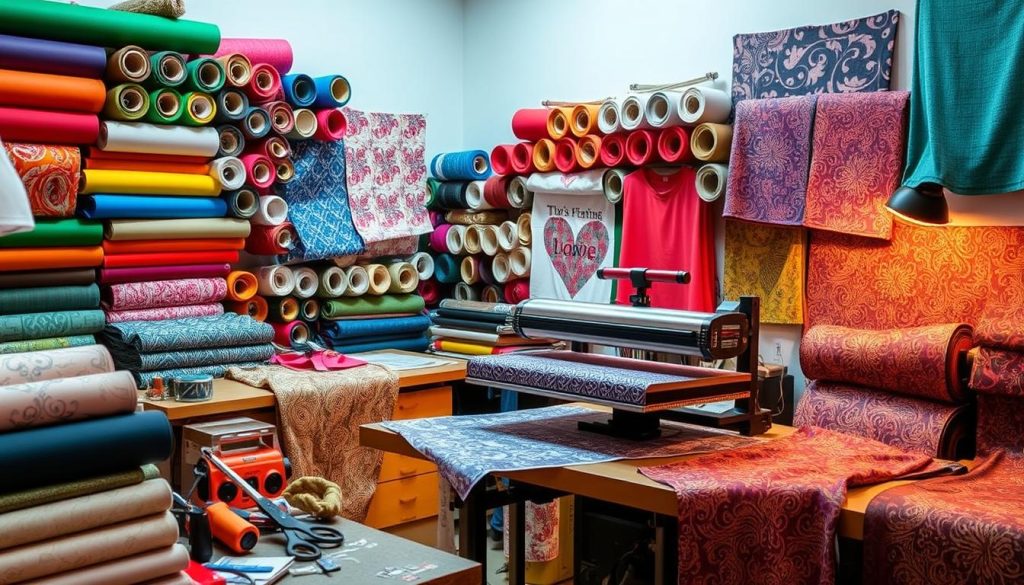HTV Printing: Easy Custom Designs for Your ProjectsHTV Printing: Easy Custom Designs for Your Projects
Ever wondered how amazing clothes are made with just a heat press and vinyl? *Custom apparel printing* has become super popular. HTV printing lets us turn our ideas into unique designs that really pop. It’s easy to start or improve your skills in *garment decoration*.
Whether it’s for special events or gifts for loved ones, HTV is a top choice. It’s perfect for crafters of all levels.

Learning HTV printing opens up a world of creativity. It lets us express our style and preferences. Let’s explore the world of heat transfer vinyl and discover how to make designs that last and look great!
Key Takeaways
- HTV printing allows for easy and creative custom designs on various fabrics.
- Standard HTV is beginner-friendly, while specialty options include glitter and flocked vinyl.
- Durability of the design increases with proper application and care.
- Pressing temperature and time are critical for the success of HTV projects.
- Testing on sample fabrics helps ensure the right choice of HTV for specific projects.
- HTV is versatile, suitable for apparel, home decor, and unique accessories.
- Considering fabric type and project goals is essential for optimal results.
Understanding Heat Transfer Vinyl (HTV)
Heat transfer vinyl (HTV) is a great way to add cool designs to clothes. It sticks to fabric when heated, unlike other vinyls. Knowing the types of heat transfer vinyl helps us pick the best for our HTV projects.
What is Heat Transfer Vinyl?
HTV is made from polyurethane and sticks to fabric when heated. We cut out our designs with a vinyl cutter and apply them with a vinyl heat press. This makes the designs last through many washes without fading.
How HTV Differs from Other Vinyl Types
HTV is special because it needs heat to work, unlike adhesive vinyl. This makes designs last longer on clothes. It’s important to know the fabric type, like polyester and spandex, for the right heat setting.
Benefits of Using HTV for Custom Designs
Using HTV has many benefits. It lets us do detailed designs and offers many finishes. It gives a professional look that lasts. Some key benefits of HTV are:
- High-tack carriers are great for detailed designs.
- There are different peeling options: Hot Peel, Warm Peel, and Cold Peel.
- It has a soft feel that’s natural on clothes.
- It stretches and rebounds well, perfect for sports clothes.
- It can be layered for complex, colorful designs.
To get good results with HTV, we need to adjust pressure, temperature, and time. A good heat press is key for the best results. Tools like alignment tools and weeding panels help us achieve high-quality designs.
For those starting with heat transfer vinyl, the money-making potential is big. With the right equipment, like a heat press and vinyl cutter, you can make a lot of money from custom T-Shirts. Knowing about HTV’s types, how to use it, and its benefits lets us be creative and make our investment worth it.
| Type of HTV | Description | Ideal Use |
|---|---|---|
| Standard HTV | Basic, versatile vinyl for everyday use | General apparel and home décor |
| Glitter HTV | Shiny finish for eye-catching designs | Fashion apparel and accessories |
| Flocked HTV | Soft texture resembling velvet | Unique garments with a premium feel |
| Reflective HTV | Enhances visibility in low light | Safety apparel and gear |
| Printable HTV | Allows full-color printing of designs | Custom graphics and photographs |
HTV Printing Process: Steps for Success
To make amazing custom designs with heat transfer vinyl (HTV), we must follow a few key steps. First, we prepare our design using htv design preparation. We use software like Adobe Illustrator or Cricut Design Space to create our cut file. It’s important to mirror the design to ensure it looks right on the final product.
This step is crucial for a perfect application and better quality in our crafts.
Preparing Your Design
Next, we start cutting HTV. We place the shiny side of the vinyl down in the vinyl cutter. Choosing the right settings for the type of HTV is key for precise cuts. We use tools like Cricut or Silhouette to weed out excess vinyl, leaving just our graphic on the carrier sheet.
This step is critical for a clean and polished result.
Heat Application Techniques
The last step is using heat application techniques. We preheat our vinyl heat press to the right temperature for the best adhesion. It’s important to place the HTV design correctly on the substrate, like a t-shirt or bag.
We cover it with a Teflon sheet or parchment paper to protect it during application. After applying heat, we peel away the carrier sheet. This solidifies our design, making it durable and attractive. Learning these techniques helps us get the most out of our HTV projects.
For more on HTV, check out this guide for tips. Visit Waxed Branding’s insights for more on improving your HTV experience.